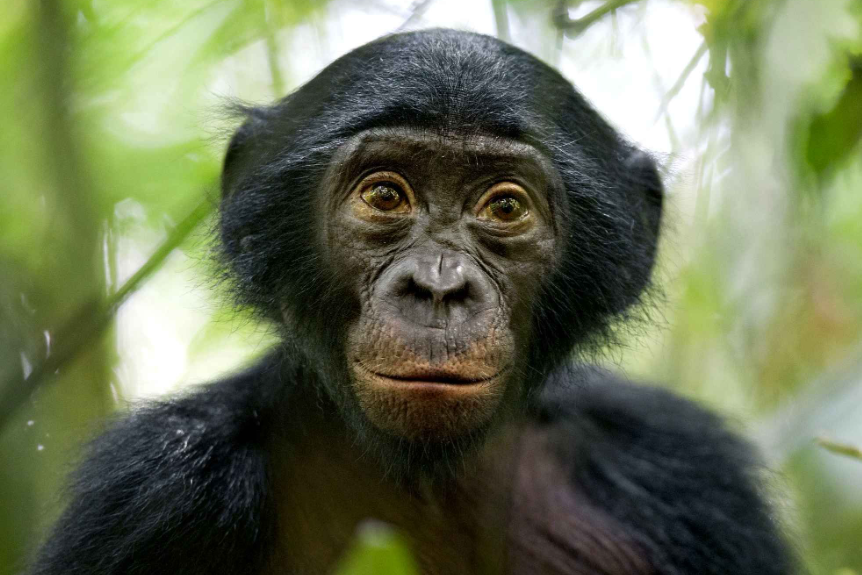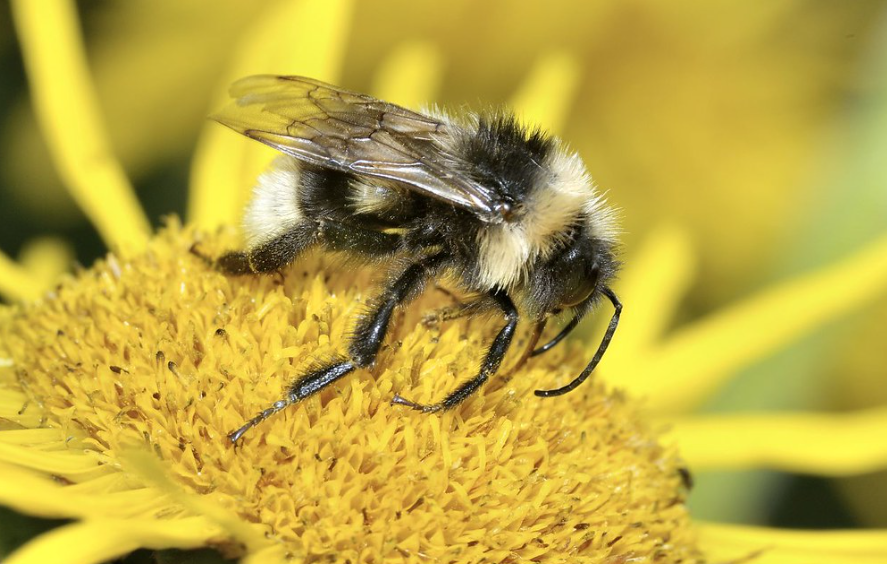
Quick Top 10 Facts about Bonobo
| SCIENTIFIC NAME | Pan paniscus |
| CLASSIFICATION | KINGDOM: Animalia PHYLUM: Chordata CLASS: Mammalia ORDER: Primates FAMILY: Hominidae GENUS: Pan SPECIES: P. paniscus |
| SIZE | Height: 1.1–1.3 meters, Weight: 40–50 kg |
| HABITAT | Rainforests of the Democratic Republic of Congo in Central Africa |
| DIET | Fruits, leaves, flowers, seeds, insects, and small vertebrates |
| SPECIES | Bonobo (Pan paniscus) is a single species |
| COUNTRY | Democratic Republic of Congo, Central Africa |
| GESTATION PERIOD | About 230–240 days |
| LIFE SPAN | 30 to 40 years in the wild, up to 50 years in captivity |
| CONSERVATION STATUS | Endangered, due to habitat loss and poaching |
Amazing Facts About Bonobos
1. Bonobos are closely related to chimpanzees
Bonobos share over 98% of their DNA with humans, making them one of our closest relatives, alongside chimpanzees.
2. They are known for their peaceful behavior
Bonobos are famous for their relatively peaceful and matriarchal societies, unlike the more aggressive chimpanzees.
3. Bonobos have a complex social structure
Their societies are organized around females who have a dominant role in decision-making and conflict resolution.
4. They use sexual behavior to resolve conflicts
Bonobos engage in sexual behaviors as a way to manage social tensions and maintain harmony within the group.
5. Bonobos are intelligent tool users
They use tools to acquire food and engage in various tasks, showing advanced problem-solving skills.
6. They are omnivores
Bonobos have a diverse diet, feeding on fruits, leaves, seeds, insects, and sometimes small vertebrates.
7. Bonobos are endangered
They are critically endangered due to habitat destruction, hunting, and the illegal pet trade.
8. They communicate through vocalizations and gestures
Bonobos use a variety of sounds, facial expressions, and body gestures to communicate with each other.
9. They live in large groups
Bonobos live in large social groups that can range from 20 to 100 individuals, often divided into smaller subgroups.
10. Bonobos are excellent swimmers
Despite being primates, bonobos are good swimmers and can often be seen crossing rivers in their natural habitat.
Introduction to the bonobo species
Bonobos, scientifically known as Pan paniscus, are a kind of large ape that lives in close proximity to humans. They are found only in the Democratic Republic of the Congo, in Central Africa. The unique social structure and conduct of bonobos set them apart from other species of primates.
Behaviours that distinguish bonobos from other primates
One of the distinctive features of the bonobos’ society is that it is matriarchal. Females lead bonobo groups, unlike other primates, where males are the majority. Women maintain a higher social status and forge solid social bonds within the group. It is said that the predominance of women contributes to the tranquil nature of bonobo societies.
Bonobos has a high level of intelligence and problem-solving abilities
Bonobos are very intelligent creatures that exhibit a range of complex activities. Their ability to solve problems, utilise tools effectively, and communicate effectively is well known. Bonobos employ a variety of vocalisations, facial expressions, and body postures to convey messages to one another. Their remarkable ability to understand and learn human language makes them a subject of study in language acquisition studies.
Unique sexual behaviour of bonobos
Another intriguing aspect of bonobos’ existence is their sexual conduct. It is well known that bonobos engage in high rates of sexual activity for a number of social functions within the group. People use sexual encounters as a social bond, a stress reliever, and a means of conflict resolution. As a result of their unusual conduct, bonobos are sometimes called “make love, not war” apes.
Food and dietary preferences of bonobos
Due to their mostly herbivorous diet, bonobos mainly eat leaves, fruits, and other parts of plants. On the other hand, they have also been seen consuming small animals and insects that sometimes include meat. As skilled gatherers, bonobos have been seen using tools to get food from difficult-to-reach areas.
Conservation efforts are in place to protect bonobos and their habitats
6. Regretfully, bonobos are now classified as endangered by the International Union for Conservation of Nature (IUCN). Their population fall has been attributed to poaching, habitat degradation, and the illegal pet trade. Conservation efforts are being made to protect their natural habitat and raise awareness of the significance of protecting these strange and fascinating species.
Fascinating facts about Bonobos
Pygmy chimpanzees, sometimes referred to as bonobos, are amazing primates that have 98.7% DNA similarity to humans. They, along with gorillas and chimpanzees, are the closest surviving cousins of humans. We’ll look at some fascinating bonobo facts in this post.
The range and habitat of bonobos
The Democratic Republic of the Congo, located in Central Africa, is home to bonobos. They live mostly in these regions’ swamps and thick jungles.
Body and physical features of bonobos
Long limbs and a thin physique characterise adult bonobos. All of their hair is black, with the exception of their face, which is often bald and has a white hair fringe around it. Compared to chimpanzees, bonobos have a more graceful bone structure and a smaller skull.
Social life and the role of female bonobos in maintaining social harmony and resolving conflicts
The Social Organisation Communities are the vast groupings in which bonobos reside. Because of the matriarchal nature of these groups, women have a greater social rank than men. Strong social ties, female dominance, and collaboration are characteristics of Bonobo culture.
Interaction and remarkable communication skills of bonobos
Bonobos use a range of vocalisations, facial gestures, and body postures to interact with one another. They can also communicate with touch and gesture in diverse ways. Studies have shown that bonobos are very adept at deciphering and reacting to social signals.
Intelligence and problem-solving abilities in bonobos
The intellect and problem-solving skills of bonobos are well recognised. In the wild, they have been seen using tools like sticks to fish food out of tree holes and stones to break nuts. This illustrates their capacity for environmental adaptation and cognitive flexibility.
Sexual interactions and the use of sex for social bonding
It is well known that bonobos have unusual sexual behaviours. They have sex not only to procreate but also to connect with one another and settle disputes. It is thought that this conduct adds to the tranquillity found in bonobo societies.

Nutrition and dietary preferences of bonobos
Since they consume mostly fruit, bonobos are classified as frugivores. But they also eat bark, flowers, seeds, leaves, and sometimes even insects. The food that is available in their ecosystem determines the variation in their diet.
Major threats faced by bonobos, endangered species
Similar to several other large ape species, bonobos are in danger of becoming extinct. One of their biggest problems is habitat loss from poaching, illicit pet trafficking, and deforestation. The IUCN Red List of Threatened Species lists bonobos as endangered.
Conservation efforts to protect the endangered bonobo species
The goal of many NGOs and conservation groups is to preserve the habitats of bonobos. Among the initiatives are awareness-building, community support, and the implementation of legal action prevention strategies. The long-term survival of bonobos depends on these efforts.
Importance of Research and Conservation of bonobo species
Researching bonobos reveals important details about the development and behaviour of humans. Because of our close genetic kinship, they are a crucial species to comprehend our common origin. Scientists may learn more about primate behaviour, cognition, and social dynamics by examining bonobos.
Unique and amazing characteristics of bonobos
Bonobos are amazing animals with distinctive traits. They are a species that should be preserved and studied because of their social structure, intellect, and close genetic kinship with humans. We can help preserve these amazing species by spreading awareness and encouraging conservation initiatives.

FAQ (Frequently Asked Questions) about Bonobo
Q: What is a Bonobo?
Ans: The Bonobo, also known as the pygmy chimpanzee, is a species of great ape closely related to the chimpanzee. They are known for their peaceful, social behavior and matriarchal social structure. Bonobos are native to the forests of the Democratic Republic of Congo in Central Africa and are one of the two species closest to humans in terms of DNA.
Q: How are Bonobos different from Chimpanzees?
Ans: While Bonobos and chimpanzees share many similarities, they differ significantly in their social behavior. Bonobos are known for being more peaceful, with a society that is matriarchal, meaning females typically hold the power in their groups. They also engage in frequent sexual behaviors to resolve conflicts, a contrast to the more aggressive social structure of chimpanzees.
Q: What do Bonobos eat?
Ans: Bonobos are omnivores, and their diet mainly consists of fruits, leaves, seeds, flowers, and small animals like insects. They are also known to hunt and eat small vertebrates, though plant matter makes up the majority of their diet.
Q: Where do Bonobos live?
Ans: Bonobos are found in the wild only in the rainforests of the Democratic Republic of Congo in Central Africa. They live in the dense, tropical forests of the Congo Basin, where they establish territories and live in large, multi-male and multi-female groups.
Q: Are Bonobos endangered?
Ans: Yes, Bonobos are considered endangered. The primary threats to their survival include habitat destruction, poaching, and the illegal pet trade. Conservation efforts are underway, but the species remains at risk due to human activities.
Q: How do Bonobos communicate?
Ans: Bonobos communicate through a combination of vocalizations, facial expressions, gestures, and body language. They are highly social animals and use these forms of communication to express emotions, convey information, and maintain group cohesion. Bonobos also use sexual behavior as a form of social bonding and conflict resolution.
Q: How intelligent are Bonobos?
Ans: Bonobos are highly intelligent animals. They have been observed using tools, exhibiting problem-solving abilities, and understanding the concept of object permanence. They also display a high level of empathy and cooperation, and their intelligence is similar to that of chimpanzees and other great apes.
Q: Do Bonobos live in groups?
Ans: Yes, Bonobos are highly social animals that live in groups, which are typically led by dominant females. These groups can range in size, and the social structure is marked by cooperation, bonding, and conflict resolution through social behaviors, including grooming and sexual interaction.
Q: Can Bonobos be kept as pets?
Ans: No, Bonobos should not be kept as pets. They are wild animals with complex social, dietary, and environmental needs. Keeping them as pets is illegal in many countries, and doing so can be harmful to both the animal and the humans involved. They are best left to live in their natural habitats or in accredited sanctuaries and zoos.
Q: Are Bonobos dangerous to humans?
Ans: Bonobos are not naturally aggressive toward humans and are generally considered peaceful creatures. However, like all wild animals, they can become dangerous if provoked or threatened. It’s important to observe them from a safe distance and respect their space.
Q: How long do Bonobos live?
Ans: In the wild, Bonobos can live up to 40-50 years, though their lifespan in captivity can sometimes extend further with proper care. Like other great apes, their life expectancy is influenced by factors like diet, environment, and social interactions.
#Bonobo, #GreatApes, #PygmyChimpanzee, #WildlifeConservation, #EndangeredSpecies, #SocialAnimals, #AnimalBehavior, #Chimpanzee, #Rainforest, #ConservationEfforts, #PrimateFacts, #BonoboConservation
Our sources and references about Bonobo
1: Wikipedia – Bonobo
2: National Geographic – Bonobo
3: Britannica – Bonobo
4: Smithsonian Magazine – Bonobos



